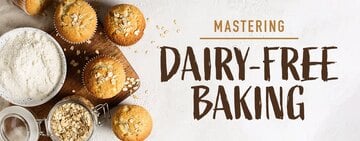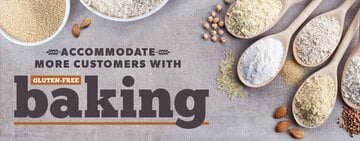Measuring Flour for Baking
One of the most common cake mistakes made while baking is measuring flour incorrectly. It may seem simple to reach into the bag with a measuring cup but this typically results in scooping out way more flour than the recipe calls for. Using too much flour can make your baked goods dense and dry. Use our guide to learn how to properly measure flour to get consistent results every time.
Shop Flour in BulkHow to Measure Flour
Use the following video to learn how to measure flour correctly:
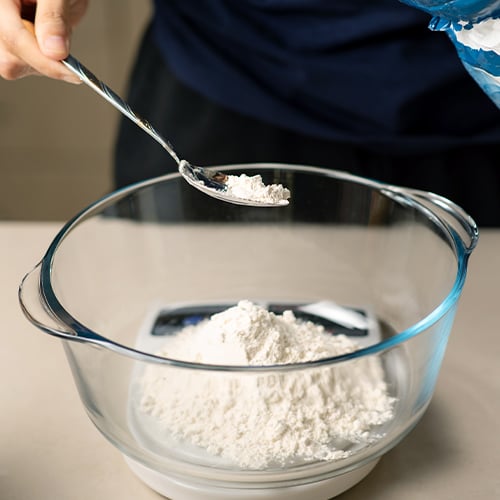
How to Measure Flour With a Scale
The best way to measure flour for baking is by using a portion scale. Flour compacts easily, so dipping a measuring spoon into the flour will lead to inconsistent results. A portion scale will allow you to measure accurately and replicate your recipe. Follow the steps below to learn how to weigh flour on a scale:
- Place a bowl on your food scale.
- Zero out your scale with the bowl on top.
- Scoop the flour into the bowl until it reaches the amount called for in the recipe.
- Sift the measured flour into your recipe to avoid clumps.
How to Measure Flour without a Scale
If you don’t have a food scale, you can still use a measuring cup for flour without overdoing it. If you dip the measuring cup into the bag, you risk getting nearly twice as much flour as necessary. Use the following technique to scoop flour correctly.
- Fluff the flour with a sifter, fine-mesh strainer, or fork to loosen it.
- Use a spoon to scoop the sifted flour into a dry measuring cup, one spoonful at a time, until overflowing.
- Gently level off the flour with the back of a knife.
Measuring Flour by Weight
So, how much should 1 cup of flour weigh? Most international recipes will have the flour weight listed in grams or ounces, but recipes in the United States will typically only list the cup measurement so you may need to do some measurement conversion. Below are some of the most common measurements for different types of flour that you’ll encounter while baking.
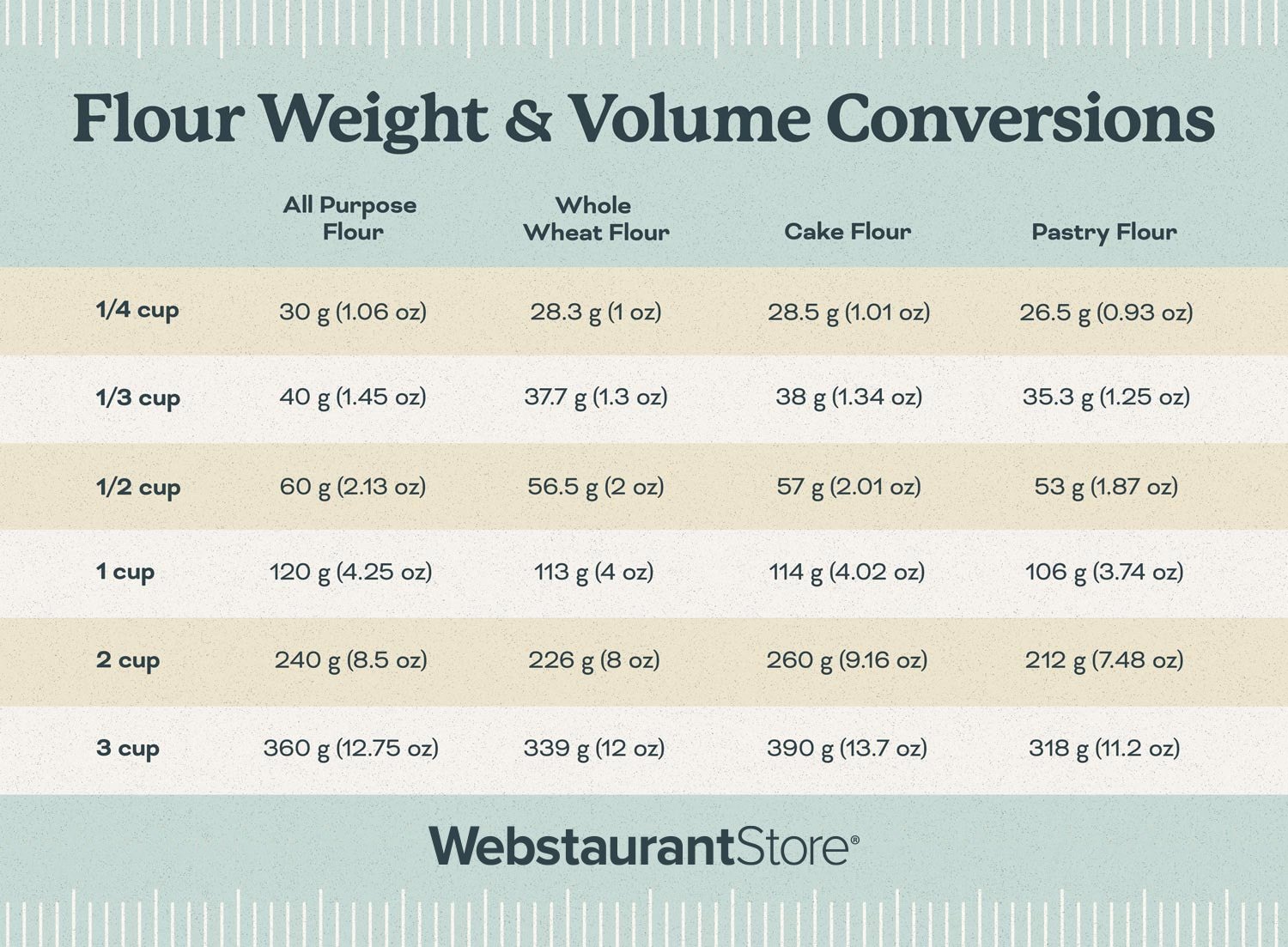
All Purpose Flour by Weight
Use these measurement conversions when weighing all-purpose flour, unbleached cake flour, and bread flour for your recipes:
- 1/4 Cup of Flour in Grams: 30 g (1.06 oz)
- 1/3 Cup of Flour in Grams: 40 g (1.45 oz)
- Half Cup of Flour in Grams: 60 g (2.13 oz)
- 1 Cup of Flour in Grams: 120 g (4.25 oz)
- 2 Cup of Flour in Grams: 240 g (8.5 oz)
- 3 Cup of Flour in Grams: 360 g (12.75 oz)
Whole Wheat Flour by Weight
Whole wheat flour is often used as a healthier alternative to all-purpose flour. Below, we’ve included common whole wheat flour measurement conversions. You can use these measurements for whole-grain flour and graham flour.
- 1/4 Cup of Whole Wheat Flour in Grams: 28.3 g (1 oz)
- 1/3 Cup of Whole Wheat Flour in Grams: 37.7 g (1.3 oz)
- Half Cup of Whole Wheat Flour in Grams: 56.5 g (2 oz)
- 1 Cup of Whole Wheat Flour in Grams: 113 g (4 oz)
- 2 Cup of Whole Wheat Flour in Grams: 226 g (8 oz)
- 3 Cup of Whole Wheat Flour in Grams: 339 g (12 oz)
Cake Flour by Weight
While unbleached flour weighs the same as all-purpose flour, bleached cake flour is lighter in color and weight than its counterpart. If you are baking with bleached cake flour, you’ll want to use the following conversions:
- 1/4 Cup of Cake Flour in Grams: 28.5 g (1.01 oz)
- 1/3 Cup of Cake Flour in Grams: 38 g (1.34 oz)
- Half Cup of Cake Flour in Grams: 57 g (2.01 oz)
- 1 Cup of Cake Flour in Grams: 114 g (4.02 oz)
- 2 Cup of Cake Flour in Grams: 260 g (9.16 oz)
- 3 Cup of Cake Flour in Grams: 390 g (13.7 oz)
Pastry Flour by Weight
Pastry flour is often used for baked goods to add a chewy texture. It has less protein content and a lower weight by volume than all-purpose flour. Here are the conversions you’ll need for baking with pastry flour:
- 1/4 Cup of Pastry Flour in Grams: 26.5 g (0.93 oz)
- 1/3 Cup of Pastry Flour in Grams: 35.3 g (1.25 oz)
- Half Cup of Pastry Flour in Grams: 53 g (1.87 oz)
- 1 Cup of Pastry Flour in Grams: 106 g (3.74 oz)
- 2 Cup of Pastry Flour in Grams: 212 g (7.48 oz)
- 3 Cup of Pastry Flour in Grams: 318 g (11.2 oz)
Measuring Flour FAQs
As a refresher, we’ve included some of the most frequently asked questions when it comes to measuring flour correctly:
What Do You Use to Measure Flour?
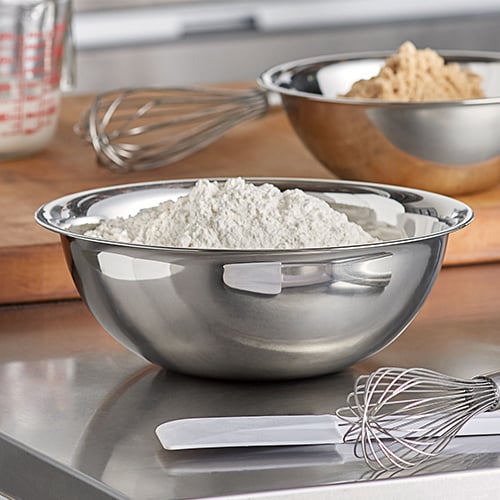
The best way to measure flour for recipes is by using a portion scale to weigh the amount needed. If you don’t own a food scale, fluff the flour and spoon it into the measuring cup before leveling it out. This keeps the flour from compacting and having too much flour in a recipe, which can make your baked goods dense and dry.
Why Should You Use a Spoon When Measuring Flour?
Dipping a measuring cup into a bag of flour packs down the flour and knocks the air out. This can result in you measuring out almost double the amount of flour that a recipe calls for. You should use a spoon to fluff the flour and sprinkle it into your measuring cup to add the air back in, giving you a more accurate measurement. If possible, use a portion scale to get the most accurate and consistent measurements for your recipes.
How Much Is 1 Cup of Flour?
There are approximately 120 g or 4.25 oz in 1 cup of flour.
How Many Grams in 2 Cups of Flour?
There are approximately 240 g or 8.5 oz. in 2 cups of flour.
Whether you operate your bakery from home or a storefront, consistency is key to the success of your business. By measuring out your flour with a scale, you can ensure that your cakes, cookies, and pastries are the perfect texture from batch to batch.

